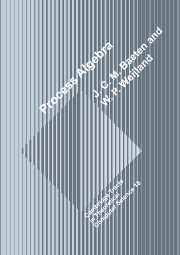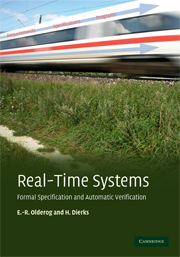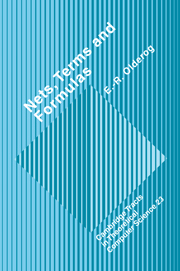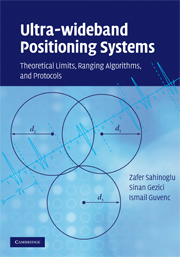Refine search
Actions for selected content:
1983 results in Distributed, Networked and Mobile Computing

Process Algebra
-
- Published online:
- 08 January 2010
- Print publication:
- 25 October 1990

Real-Time Systems
- Formal Specification and Automatic Verification
-
- Published online:
- 06 January 2010
- Print publication:
- 11 September 2008

Nets, Terms and Formulas
- Three Views of Concurrent Processes and their Relationship
-
- Published online:
- 06 January 2010
- Print publication:
- 03 October 1991

Ultra-wideband Positioning Systems
- Theoretical Limits, Ranging Algorithms, and Protocols
-
- Published online:
- 23 December 2009
- Print publication:
- 04 September 2008
9 - Timing
-
- Book:
- Process Algebra: Equational Theories of Communicating Processes
- Published online:
- 05 July 2014
- Print publication:
- 16 December 2009, pp 301-334
-
- Chapter
- Export citation
Preface
-
- Book:
- Process Algebra: Equational Theories of Communicating Processes
- Published online:
- 05 July 2014
- Print publication:
- 16 December 2009, pp xiii-xvi
-
- Chapter
- Export citation
Index of Authors
-
- Book:
- Process Algebra: Equational Theories of Communicating Processes
- Published online:
- 05 July 2014
- Print publication:
- 16 December 2009, pp 435-438
-
- Chapter
- Export citation
7 - Parallel and communicating processes
-
- Book:
- Process Algebra: Equational Theories of Communicating Processes
- Published online:
- 05 July 2014
- Print publication:
- 16 December 2009, pp 195-244
-
- Chapter
- Export citation
12 - Semantics
-
- Book:
- Process Algebra: Equational Theories of Communicating Processes
- Published online:
- 05 July 2014
- Print publication:
- 16 December 2009, pp 393-410
-
- Chapter
- Export citation
3 - Transition systems
-
- Book:
- Process Algebra: Equational Theories of Communicating Processes
- Published online:
- 05 July 2014
- Print publication:
- 16 December 2009, pp 35-66
-
- Chapter
- Export citation
2 - Preliminaries
-
- Book:
- Process Algebra: Equational Theories of Communicating Processes
- Published online:
- 05 July 2014
- Print publication:
- 16 December 2009, pp 11-34
-
- Chapter
- Export citation
Foreword
-
-
- Book:
- Process Algebra: Equational Theories of Communicating Processes
- Published online:
- 05 July 2014
- Print publication:
- 16 December 2009, pp x-xi
-
- Chapter
- Export citation
Foreword
-
-
- Book:
- Process Algebra: Equational Theories of Communicating Processes
- Published online:
- 05 July 2014
- Print publication:
- 16 December 2009, pp ix-x
-
- Chapter
- Export citation
5 - Recursion
-
- Book:
- Process Algebra: Equational Theories of Communicating Processes
- Published online:
- 05 July 2014
- Print publication:
- 16 December 2009, pp 109-170
-
- Chapter
- Export citation
1 - Process algebra
-
- Book:
- Process Algebra: Equational Theories of Communicating Processes
- Published online:
- 05 July 2014
- Print publication:
- 16 December 2009, pp 1-10
-
- Chapter
- Export citation
Frontmatter
-
- Book:
- Process Algebra: Equational Theories of Communicating Processes
- Published online:
- 05 July 2014
- Print publication:
- 16 December 2009, pp i-iv
-
- Chapter
- Export citation
4 - Basic process theory
-
- Book:
- Process Algebra: Equational Theories of Communicating Processes
- Published online:
- 05 July 2014
- Print publication:
- 16 December 2009, pp 67-108
-
- Chapter
- Export citation
10 - Data and states
-
- Book:
- Process Algebra: Equational Theories of Communicating Processes
- Published online:
- 05 July 2014
- Print publication:
- 16 December 2009, pp 335-374
-
- Chapter
- Export citation
Contents
-
- Book:
- Process Algebra: Equational Theories of Communicating Processes
- Published online:
- 05 July 2014
- Print publication:
- 16 December 2009, pp v-viii
-
- Chapter
- Export citation
Index of Symbols and Notations
-
- Book:
- Process Algebra: Equational Theories of Communicating Processes
- Published online:
- 05 July 2014
- Print publication:
- 16 December 2009, pp 421-434
-
- Chapter
- Export citation
